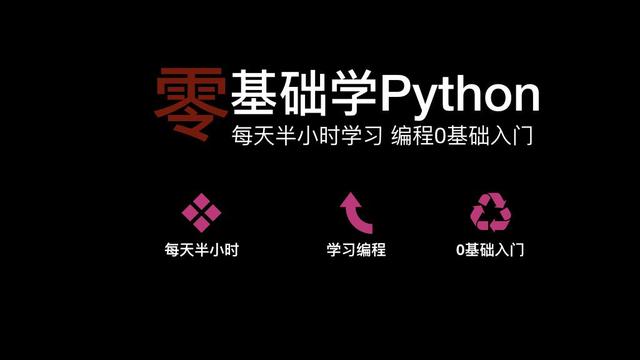
引言
作为一门以简洁和易学著称的编程语言,Python 近年来在各个领域得到了广泛应用。从数据科学到Web开发,从自动化到人工智能,Python 以其强大的库和社区支持,使得它成为新手和经验丰富的开发者的首选。
在本文中,我们将从零基础开始,逐步深入,涵盖Python 3的基础知识、进阶技巧和实用案例,帮助您全面掌握这门语言。
1. Python 3基础知识
1.1 安装与设置
在开始学习Python编程之前,首先需要安装Python 3。可以从 Python 官方网站 下载最新版本的Python。安装完成后,可以通过命令行或终端输入 python --version 来检查安装是否成功。
1.2 基本语法
Python的语法非常直观,下面是一些基本语法的示例:
- 变量和数据类型
# 整数 x = 10 # 浮点数 y = 3.14 # 字符串 name = "Alice" # 布尔值 is_active = True- 注释
# 这是单行注释 """ 这是多行注释 可以跨越多行 """- 基本运算
a = 5 b = 3 # 加法 print(a + b) # 输出: 8 # 减法 print(a - b) # 输出: 2 # 乘法 print(a * b) # 输出: 15 # 除法 print(a / b) # 输出: 1.666... # 取整除法 print(a // b) # 输出: 1 # 取余 print(a % b) # 输出: 2 # 幂运算 print(a ** b) # 输出: 125- 条件语句
age = 18 if age >= 18: print("成年") else: print("未成年")- 循环
# for循环 for i in range(5): print(i) # 输出: 0 1 2 3 4 # while循环 count = 0 while count < 5: print(count) count += 1 # 输出: 0 1 2 3 41.3 数据结构
Python 内置了几种常用的数据结构,如列表、元组、集合和字典。
- 列表
fruits = ["apple", "banana", "cherry"] fruits.append("orange") # 添加元素 print(fruits) # 输出: ['apple', 'banana', 'cherry', 'orange']- 元组
dimensions = (1920, 1080) print(dimensions[0]) # 输出: 1920- 集合
unique_numbers = {1, 2, 3, 4, 5} unique_numbers.add(6) print(unique_numbers) # 输出: {1, 2, 3, 4, 5, 6}- 字典
person = {"name": "Alice", "age": 30} print(person["name"]) # 输出: Alice person["age"] = 31 # 更新值 print(person) # 输出: {'name': 'Alice', 'age': 31}2. 进阶技巧
2.1 函数和模块
- 定义函数
def greet(name): return f"Hello, {name}!" print(greet("Alice")) # 输出: Hello, Alice!- 使用模块
Python 提供了丰富的标准库,可以直接导入使用。
import math print(math.sqrt(16)) # 输出: 4.02.2 面向对象编程
- 类和对象
class Dog: def __init__(self, name, age): self.name = name self.age = age def bark(self): return "Woof!" my_dog = Dog("Buddy", 3) print(my_dog.bark()) # 输出: Woof!- 继承
class Animal: def __init__(self, name): self.name = name def speak(self): raise NotImplementedError("Subclass must implement abstract method") class Cat(Animal): def speak(self): return "Meow" my_cat = Cat("Whiskers") print(my_cat.speak()) # 输出: Meow2.3 文件操作
# 写入文件 with open("example.txt", "w") as file: file.write("Hello, World!") # 读取文件 with open("example.txt", "r") as file: content = file.read() print(content) # 输出: Hello, World!2.4 异常处理
try: result = 10 / 0 except ZeroDivisionError: print("除数不能为零") finally: print("执行结束")2.5 高级函数与函数式编程
- 匿名函数 (Lambda)
square = lambda x: x ** 2 print(square(5)) # 输出: 25- 映射与过滤
# 映射 numbers = [1, 2, 3, 4, 5] squared_numbers = list(map(lambda x: x ** 2, numbers)) print(squared_numbers) # 输出: [1, 4, 9, 16, 25] # 过滤 even_numbers = list(filter(lambda x: x % 2 == 0, numbers)) print(even_numbers) # 输出: [2, 4]3. 实用案例
3.1 数据分析
使用Python进行数据分析,常用的库包括Pandas和NumPy。
- Pandas与数据操作
import pandas as pd # 创建DataFrame data = { "Name": ["Alice", "Bob", "Charlie"], "Age": [25, 30, 35], "City": ["New York", "Los Angeles", "Chicago"] } df = pd.DataFrame(data) print(df) # 数据选择与过滤 print(df[df["Age"] > 30]) # 输出年龄大于30的数据行- NumPy与数组计算
import numpy as np # 创建数组 arr = np.array([1, 2, 3, 4, 5]) print(arr * 2) # 输出: [ 2 4 6 8 10] # 数组运算 print(np.mean(arr)) # 输出: 3.03.2 Web开发
Python 3在Web开发中的应用广泛,Flask和Django是两个常用的Web框架。
- Flask示例
from flask import Flask app = Flask(__name__) @app.route("/") def home(): return "Hello, Flask!" if __name__ == "__main__": app.run(debug=True)- Django示例
# 创建Django项目 django-admin startproject mysite # 进入项目目录 cd mysite # 启动服务器 python manage.py runserverDjango 提供了丰富的功能,如ORM、管理后台和表单系统,使得开发复杂的Web应用变得更加简单。
3.3 自动化脚本
Python 3可以用来编写各种自动化脚本,简化日常工作。
- 网页抓取
import requests from bs4 import BeautifulSoup url = "https://www.example.com" response = requests.get(url) soup = BeautifulSoup(response.text, "html.parser") # 获取所有链接 links = soup.find_all("a") for link in links: print(link.get("href"))- 文件管理
import os # 遍历目录 for root, dirs, files in os.walk("."): for file in files: print(os.path.join(root, file))4. 总结
Python 3作为一门功能强大且易于学习的编程语言,已经成为开发者社区中的重要组成部分。无论是初学者还是有经验的开发者,都可以从中找到适合自己的工具和方法。
在本文中,我们从基础知识出发,逐步深入到进阶技巧,并结合实际案例展示了Python 3的多种应用场景。希望这篇指南能帮助您更好地理解和掌握Python 3,开启您的编程之旅。

 鲁公网安备37020202000738号
鲁公网安备37020202000738号